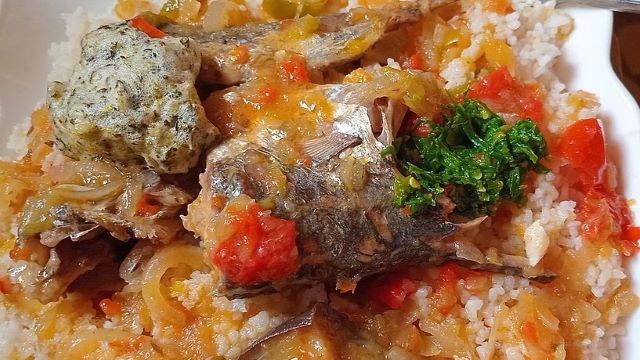On the streets of Bissau, the nation’s capital, the aroma of simmering stews mingles with the smoky scent of fish grilling over open coals. In markets, baskets overflow with mangoes, guavas, and cassava, while vendors ladle out rice dishes seasoned with tomatoes and peppers. Food in Guinea-Bissau is more than sustenance; it is a mirror of history, community, and the rhythms of everyday life.
Situated on West Africa’s Atlantic coast, the country’s cuisine reflects a marriage of indigenous traditions with Portuguese influences left from centuries of colonial rule. The result is a distinctive culinary identity, one that carries the imprint of both land and sea. Rice stands at its core. From celebratory gatherings to daily meals, it appears in many forms—none more beloved than jollof rice, a one-pot dish rich with tomato, onion, and spice, often accompanied by grilled fish or chicken.
Seafood, abundant along the coast and rivers, is another pillar of the local table. Caldeirada, a hearty fish stew, embodies this maritime heritage. Prepared with palm oil, peppers, and seasonings that vary by household, it nods to Portuguese stews while remaining firmly rooted in local taste. Grilled barracuda or snapper, seasoned simply and served with rice, speaks to the resourcefulness of coastal communities.
Equally present are vegetable-based dishes built on staples such as corn, cassava, and okra. Couscous-like preparations made from cornmeal or cassava flour are common, served with vegetables and occasionally meat or fish. These plates highlight the reliance on locally grown produce—sweet potatoes, leafy greens, and legumes—ingredients that anchor both sustenance and flavor.
No survey of Guinean cuisine would be complete without piri-piri, the fiery chili sauce that has traveled far beyond the country’s borders. Used as marinade, accompaniment, or simple dipping sauce, it infuses even the most modest dish with intensity. At the table, it is often present in a small bowl, a communal gesture that underscores food’s role in social exchange.
Sweets offer another layer of the country’s culinary story. Baba de camelo, a caramel pudding made from condensed milk and eggs, reflects Portuguese influence, while tropical fruits—coconuts, papayas, and mangoes—remain the simplest and most beloved desserts, eaten fresh in the heat of the afternoon.
Behind each recipe lies continuity. Knowledge passes from one generation to the next, often in kitchens where families gather to cook communally. In rural villages, the pounding of cassava in wooden mortars echoes across courtyards; in urban homes, dishes adapt to shifting tastes but preserve familiar flavors. The result is a cuisine that remains resilient, evolving without losing its roots.
For Guinea-Bissau, food is inseparable from cultural identity. Each meal is both nourishment and narrative, tying together influences from across centuries into a living tradition. In the everyday act of cooking and sharing, the nation’s past and present come together at the table.
Sources
- Carvalho, Clara. Food, Culture and Identity in Guinea-Bissau. Instituto de Ciências Sociais, University of Lisbon, 2011.
- Lobban, Richard A. Historical Dictionary of the Republic of Guinea-Bissau. Rowman & Littlefield, 2019.
- Mbodj, Mohamed. “Food and Foodways in West Africa.” Journal of African Cultural Studies, vol. 17, no. 1, 2005, pp. 11–26.
- UNESCO. “Guinea-Bissau: Cultural Heritage and Community Practices.” UNESCO Intangible Cultural Heritage Reports, 2022.


